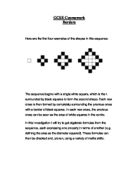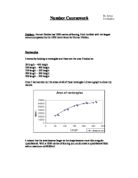e.g.)
After looking at this diagram I worked out that the width of this shape would be:
2n + 1. This also works for all of the other shapes in the sequence here is a table to prove it.
Perimeter
If I count the number of black squares in each shape (perimeter) and then put them into a table along with the n’th term of the shape then I should be able to see a pattern and work out a formula for the perimeter.
From this table it becomes obvious to see that the formula for the perimeter of the shape is P = 4n
If you divide the perimeter of a cross by four to obtain a single side of the cross then you can see why this works. The length of one side is exactly the same as n. The length of one side must be multiplied by 4 to give the perimeter and for this reason P = 4n.
Area
To work out this formula I will draw a diagram that finds out the differences between consecutive terms, and then the differences between those differences.
N: 0 1 2 3
Area: 1 5 13 25
4 8 12
4 4
Because the diagram needs to go down two levels the find the difference between the adjacent numbers, we know that there must be an n2 term in there somewhere and that the formula will be quadratic.
To work out the rest of the formula I used this table:
The area minus 2n2 always leaves a number that is equal to 2n+1
Therefore the formula must be 2n2 + 2n + 1
We must now test the formula with the next cross in the series, which has a value of n equal to four.
When we substitute the value four for n in our formula, we get:
2(4)2 + 2(4) + 1 =41
When I counted the number of squares in the cross above they came to 41 which proves that my theory is correct.
The reason that this formula works is because the 2n+1 part of the formula is the diameter formula as well, giving us the row of squares across the middle of the cross. Therefore the 2n2 must be the rest of the circle. Because it is 2n2 then it must be possible to split in to two equal parts each part being n2. n2 must equal the part of the cross above or below the row of squares worked out by 2n+1.
I will also try the formula out on the next cross to see if it works.
The n value of this cross is 6.
I have counted the squares manually in the cross and there were 85 squares altogether.
So:
2n2 + 2n +1
2(6)2 + 2(6) + 1
72 + 12 + 1
= 85
Again the formula works. I wont draw out any more of the crosses because I think we have drawn enough. Now I will draw a table showing the area of the next few crosses in the sequence by using the formula to work it out.







